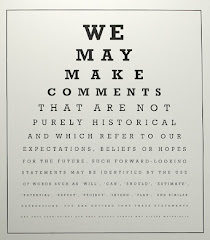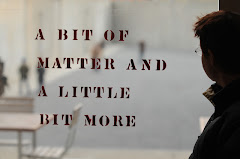Language as Sculpture, Words as Clay
By RANDY KENNEDY
Published: October 21, 2007, The New York Times
[...]
In a recent interview at his temporary studio, as the construction drill droned on outside, Mr. Weiner, a tall, thin man with a trademark flowing Moses beard, seemed not to notice the noise anymore, speaking in a quiet, smoke-deepened basso-profundo. He said that while people had gradually accepted a wide range of nontraditional materials as being within the realm of sculpture — Mr. Andre’s plain, stacked fire bricks or metal tiles; Dan Flavin’s fluorescent tubes; Bruce Nauman’s painted body — using only language as a material seemed to be going way too far. (Mr. Weiner’s actual way of describing this, evoking his years on the docks, can’t be printed in this newspaper.)
But his use of language was not intended to be confrontational, he said. It was democratic, to make art that was open-ended and able to adapt easily to different contexts and even different cultures. He has made work in dozens of countries, translated into dozens of languages.
“If it’s successful, the work really becomes part of people’s lives,” Mr. Weiner said, relating, as he rolled a cigarette from pouch of tobacco, a story of a late-night cab ride in Vienna. The cabdriver talked proudly about one of Mr. Weiner’s pieces in that city — the words “Smashed to Pieces (in the Still of the Night)” painted in huge letters atop a Nazi-era military tower in 1991 — not knowing or caring, really, who made the work and certainly not realizing that the creator was in the back seat of his cab.
More.
When you are dealing with language, there is no edge that the picture drops over or drops off. You are dealing with something completely infinite. Language, because it is the most non-objective thing we have ever developed in this world, never stops. Lawrence Weiner
language + the materials referred to
Lawrence Weiner designates “language + the materials referred to” as the medium for his work, allowing him to situate his sculptural practice in a wide range of geographical locations and cultural systems (or “points of reception”, in Weiner’s words). This course explores writing as a creative and critical strategy through themes such as art writing; materiality and genre; the aesthetics of the dematerialized artifact; language as sculpture, sound art, and the role of language in conceptual art.
Carey Young

Cautionary Statement (2007)
COURSE TEXTS
- Birgit Pelzer & John Goodman (1999), Dissociated Objects: The Statements/Sculptures of Lawrence Weiner (October, Vol. 90, pp. 76-108. Available via JSTOR)
- Course blog
- Donald Judd (1965) Specific Objects (in Thomas Kellein, Donald Judd: Early Work, 1955-1968, New York: D.A.P., 2002. Originally published in Arts Yearbook 8, 1965. Available via course blog).
- Jack Burnham (1968), ”System Esthetics” in Artforum
- Silvia Kolbowski (2000) An Inadequate History of Conceptual Art (October, Vol. 92, pp. 52-70. Available via JSTOR)
- Simon Morley: Writing on the Wall: Word and Image in Modern Art (Berkeley and Los Angeles: University of California Press, 2003)
- The Prose Poem: An International Journal
- Ubuweb
- W.J.T. Mitchell (1994), “Ekphrasis and the Other” in Picture Theory
A bit of matter and a little bit more

Lawrence Weiner (1976)
In the buginning is the woid, in the muddle is the sounddance.
James Joyce
James Joyce
Marcel Broodthaers holding Sadoul's L'Invention du Cinéma

Photo: Joaquin Romero Frias
"Let's waltz the rumba."
Fats Waller
This is...
7. This is not philosophy, it’s poetry. And if I say so, then it becomes painting, music or sculpture, judged as such. If there are variables to consider, they are at least partly economic—the question of distribution, etc. Also differing critical traditions. Could this be good Poetry, yet bad music? But yet I do not believe I would, except in jest, posit this as dance or urban planning.
from The Chinese Notebook
by Ron Silliman
from The Chinese Notebook
by Ron Silliman
Alice's Adventures in Wonderland
ALICE was beginning to get very tired of sitting by her sister on the bank and of having nothing to do: once or twice she had peeped into the book her sister was reading, but it had no pictures or conversations in it, "and what is the use of a book," thought Alice, "without pictures or conversations?'
Lewis Carroll
Lewis Carroll

from Philosophical Investigations
Our language can be seen as an ancient city: a maze of little streets and squares, of old and new houses, and of houses with additions from various periods; and this surrounded by a multitude of new boroughs with straight regular streets and uniform houses.
Ludwig Wittgenstein
Ludwig Wittgenstein
Word and Image Masters Course
Class of 2008 course blog
Rui Tenreiro
Roberta Burchardt (PDF available on request)
Merve Ertufan
Class of 2009:
Rui Tenreiro
Roberta Burchardt (PDF available on request)
Merve Ertufan
Induction valve (Soupape d'admission) by Francis PICABIA

50x33 cm. Gouache over an engineering blueprint. Private collection.
ART & CONCEPTUAL WRITING
Dada stirs up everything (Dada soulève tout)

15 January, 1921
PERFORMANCE WRITING & SOUND POETRY
The Bearded heart (Le Coeur à barbe)

Sole issue of a "transparent newspaper" published by Tristan Tzara in April 1922. 2x14 cm., 8 p. Black printing on pink paper.
RHETORIC & EKPHRASIS
SPIRIT VESSEL by Katherine Ng

WORKING NOTE: SPIRIT VESSEL is letterpress printed artist book produced through a Brody Arts Fund Grant. The hand set type was printed on two sides of the paper, then cut into strips (pages) and woven into the shape of a gourd. The text lists the uses of gourds from different cultures and so does the title of this piece. In the Chinese culture, the gourd is used as a container to capture evil spirits, whereas in the Japanese culture, the gourd is used as a vessel for intoxicating spirits.
Blog Archive
-
▼
2008
(42)
-
▼
January
(14)
- Dieter Roth«Black page with holes (poetry machine)...
- RobopoeticsAt all events my own essays and dissert...
- Language as Sculpture, Words as ClayBy RANDY KENNE...
- WattHere he stood. Here he sat. Here he knelt. ...
- THE UBUWEB :: ANTHOLOGY OF CONCEPTUAL WRITINGintro...
- Picture Writing[I]t is quite beyond doubt that the...
- Fools lament the decay of criticism. … Criticism i...
- Stephen Mallarmé: "Un Coup de Dés / jamais n' abol...
- Lawrence Weiner Essay by Lynne Cooke Since 1967 La...
- Word SaladThe Dadaists attached much less importan...
- The Well-Shaped Phrase as ArtBy ROBERTA SMITHPubli...
- Dartington College of Arts specialises in teaching...
- Pierre Bayard's How to Talk About Books You Haven'...
- ekphrasis If the dialectic of word and image is ce...
-
▼
January
(14)
About Me
- Rolf Hughes
- Writer & critic; Guest Professor in Theory and Practice-Based Research at the Department of Interdisciplinary Studies at Konstfack University College of Arts, Crafts and Design, Stockholm; Senior Professor in Research Design at the Sint-Lucas School of Architecture, Brussels & Ghent; Senior Researcher at the Royal Institute of Technology, School of Architecture, Stockholm.